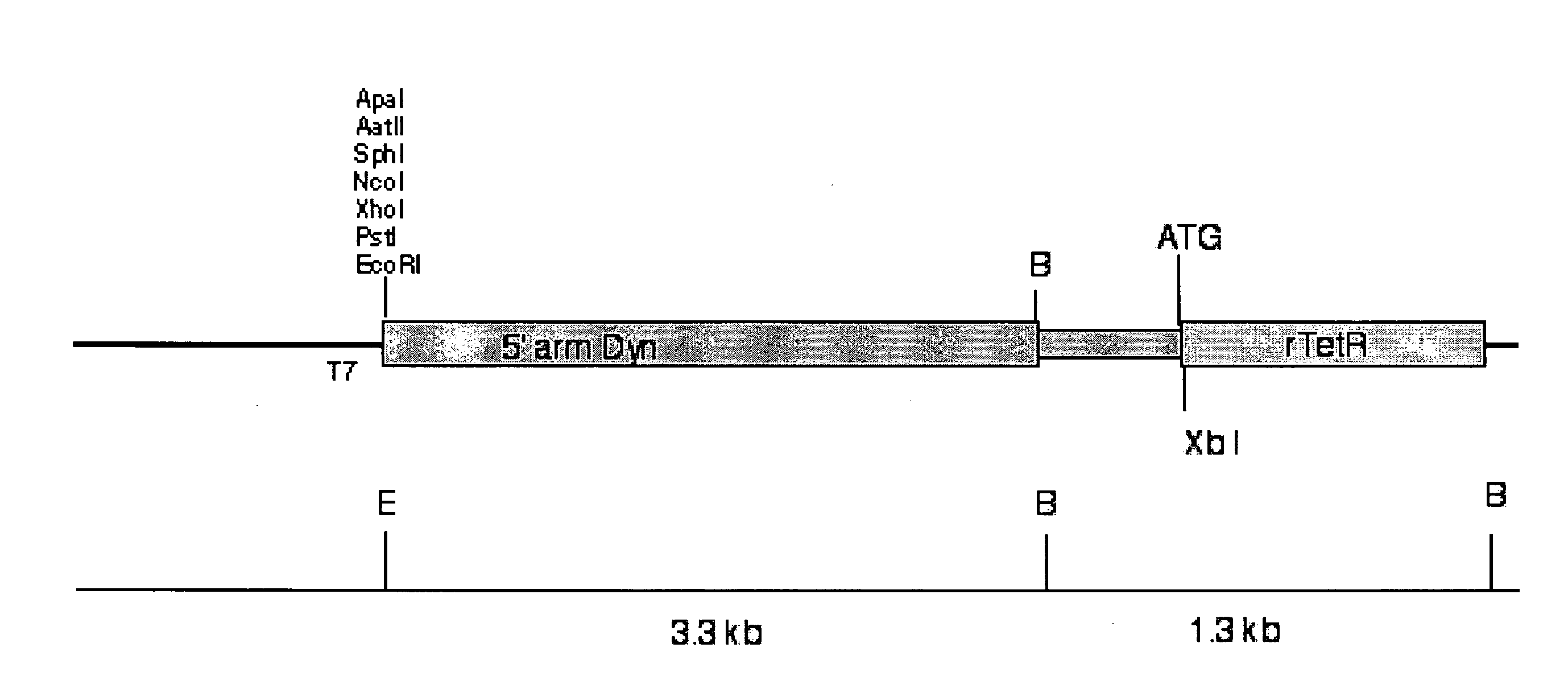Modified Dynorphin Expression in Animals and Identification of Compounds for Treatment of Obesity and Diabetes
a technology of dynorphin and animal body, applied in the field of transgenic, can solve the problems of ineffective thermal effect, poor long-term prognosis for weight loss, and effect that may not be opiate receptor-mediated, and achieve the effect of reducing glucose intolerance and increasing body weight reduction
- Summary
- Abstract
- Description
- Claims
- Application Information
AI Technical Summary
Benefits of technology
Problems solved by technology
Method used
Image
Examples
example 1
Production of a Dynorphin Knockout Mouse
[0230]A 129 / SvJ genomic bacterial artificial chromosome (BACS) library (Genome Systems, St. Louis, USA) was screened under high stringency conditions using a probe specific to the mouse Dyn (dynorphin) gene. Clones detected by the probe were isolated and mapped using restriction endonuclease digestion. For example, the BACs were mapped using EcoRI digestion and / or BstEll digestion or EcoRi digestion and / or NdeI digestion, amongst other restriction endonucleases.
[0231]Fragments produced by EcoRI digestion were subcloned into the pBluescript vector (Stratagene) and used as the 5′ arm of a targeting construct.
[0232]Nucleic acid encoding the retroviral tetracycline repressible element (rtetR) was cloned such that the start codon of dynorphin forms the start codon of rtetR. Accordingly, expression of this region produces the doxycycline sensitive repressor gene product.
[0233]Nucleic acid encoding the enhanced green fluorescent protein was then clon...
example 2
Effects of Reducing Dynorphin Expression on Bodyweight, Body Fat Content, Appetite and Activity
Animals
[0244]All research and animal care procedures were approved by the Garvan Institute / St Vincent's Hospital Animal Experimentation Ethics Committee and were in agreement with the Australian Code of Practice for the Care and Use of Animals for Scientific Purpose. Mice were housed under conditions of controlled temperature (22° C.) and illumination (12 hour light cycle, lights on at 7.00 h).
Diets
[0245]Half of the mice of each genotype were fed a normal chow diet ad libitum (6% calories from fat, 21% calories from protein, 71% calories from carbohydrate, 2.6 kilocalories / g, Gordon's Speciality Stock Feeds, Yanderra, NSW, Australia). The other half was fed ad libitum with a high-fat diet supplemented with fat and sucrose (46% calories from fat, 21% calories from protein, 33% calories from carbohydrate, 4.72 kilocalories / g) from 4 weeks of age onwards. The diet was based on the composition...
example 3
Effect of Reduced Dynorphin Expression on Glucose Homeostasis
[0258]At 13-14 weeks of age animals were fasted overnight and then administered an intraperitoneal injection of D-glucose (1.0 g / kg). Blood samples were collected from the tail at 0, 15, 30, 60, 90, and 120 minutes post injection for determination of serum glucose and insulin levels.
Tissue Collection and Analysis.
[0259]At 14-15 weeks of age, mice were killed by cervical dislocation in the morning for collection of trunk blood. Serum insulin levels were measured by radioimmunoassay kits from Linco Research (St. Louis, Mo., USA) or an ultrasensitive enzyme immunoassay for post-glucose serum samples (Mercodia AB, Uppsala, Sweden).
Results
[0260]To determine whether dynorphin ablation affects serum insulin levels and glucose tolerance, in vivo glucose tolerance tests were performed.
[0261]In chow-fed animals, dynorphin deficiency improves glucose tolerance. In male dynorphin− / − mice the peak in glycemia wa...
PUM
| Property | Measurement | Unit |
|---|---|---|
| Angle | aaaaa | aaaaa |
| Electrical conductance | aaaaa | aaaaa |
| Electrical conductance | aaaaa | aaaaa |
Abstract
Description
Claims
Application Information
 Login to View More
Login to View More - R&D
- Intellectual Property
- Life Sciences
- Materials
- Tech Scout
- Unparalleled Data Quality
- Higher Quality Content
- 60% Fewer Hallucinations
Browse by: Latest US Patents, China's latest patents, Technical Efficacy Thesaurus, Application Domain, Technology Topic, Popular Technical Reports.
© 2025 PatSnap. All rights reserved.Legal|Privacy policy|Modern Slavery Act Transparency Statement|Sitemap|About US| Contact US: help@patsnap.com



